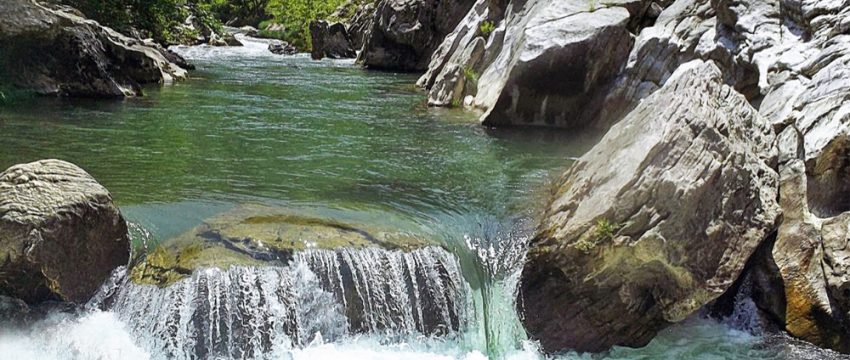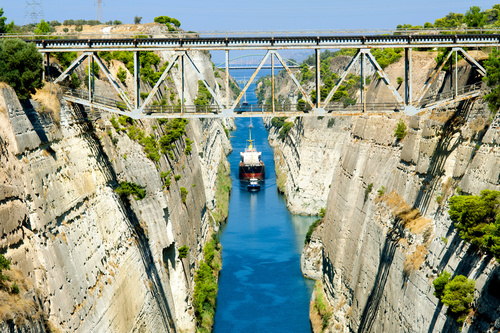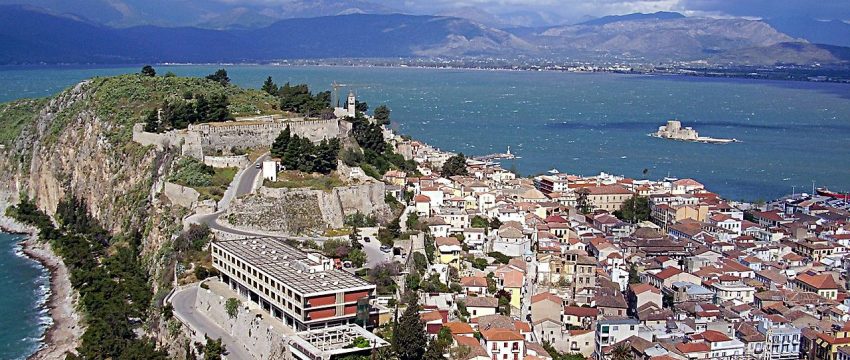Regarded as one of the most romantic cities all overGreece, Nafplion was the first capital of the newly born Greek state between 1823 and 1834.
Includes a visit to the following sites and areas:
- Corinth Canal
- Palamidi Fortress
- Nafplion old town
- Castle of Bourtzi
Description:
After meeting your driver you will depart Athens and drive along the coast. You will access the peninsula by crossing the awe-inspiring Corinth Canal. You will realize the enormity of the achievement as you will have the opportunity to photograph it en route. After the Corinth Canal,you will continue on to Nafplion.

Named after the mythical Nafplios, son of Poseidon, Nafplio first started to develop in the 7th century BC and since then it has known prosperity and progress but also invasions and occupation by many foreign conquerors.
Nafplion today is a charming town, built by the seaside on the feet of two fortresses, Palamidi and Akronafplia and is full of neoclassical buildings, paved squares, and picturesque alleys.
Your first visit of today is the Palamidi Fortress.Nestled on the crest of a 216-metre high hill, the fortress was built by the Venetians during their second occupation of the area (1686–1715).The bastions of the fortress were originally named after the Venetian provveditori. However, when it fell to the Ottoman Empire, the bastions were given Turkish names. Lastly, when the Greeks overthrew the Turks the bastions were renamed after Greek saints. One of the bastions, called the «Miltiades» ,was used as the prison cell of Theodoros Kolokotronis, a hero of the Greek Revolution.The fortress commands an impressive view over the Argolic Gulf, the city of Náfplio and the surrounding country.
After this visit, you meet your driver again to drive you back to Nafplion port where you will enjoy a 5min boat ride to the castle of Bourtzi located in the middle of the harbour of Nafplio. The Venetians completed its fortification in 1473 to protect the city from pirates and invaders from the sea. The Greeks regained it from the Turks on June 18, 1822, from where they assisted in the siege of Nafplio. Until 1865 it served as a fortress. It was then transformed into residence of the executioners of convicts from the castle of Palamidi. From 1930 to 1970, it served as a hotel. Now,you will be free to explore on your own this beautiful town, explore its alleys, sit by the waterfront at one of the many ouzeris overlooking the small island of Bourtzi and taste the traditional mezedes of sea food and not only, taste the best Gelato in Greece.
Nafplio (Modern Greek: Ναύπλιο, Nafplio) is a seaport town in the Peloponnese in Greece that has expanded up the hillsides near the north end of the Argolic Gulf. The town was an important seaport held under a succession of royal houses in the Middle Ages as part of the lordship of Argos and Nauplia, held initially by the de la Roche following the Fourth Crusade before coming under the Republic of Venice and, lastly, the Ottoman Empire. The town was the capital of the First Hellenic Republic and of the Kingdom of Greece, from the start of the Greek Revolution in 1821 until 1834. Nafplio is now the capital of the regional unit of Argolis






 After your visit to the museum, rejoin your transportation and begin the drive back to Athens. Along the way, a stop will be made for a traditional Greek lunch. After lunch, you will start your drive back to Athens.
After your visit to the museum, rejoin your transportation and begin the drive back to Athens. Along the way, a stop will be made for a traditional Greek lunch. After lunch, you will start your drive back to Athens.








